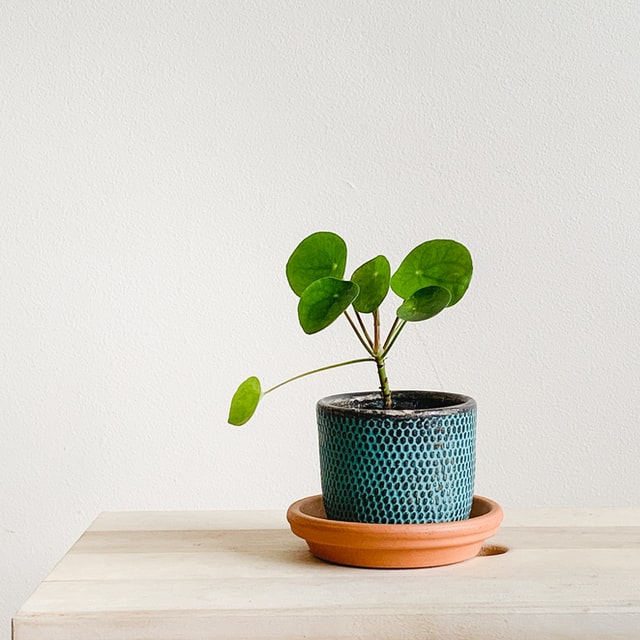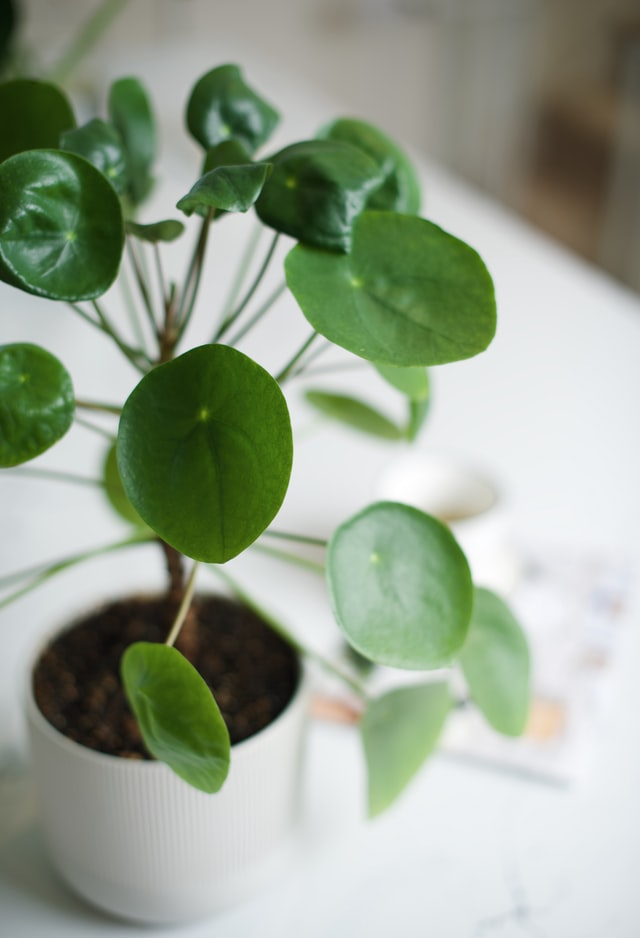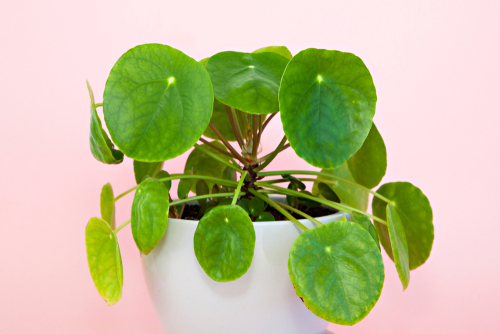As an Amazon Associate, I earn from qualifying purchases
The Chinese Money Plant, also known as the Pilea peperomioides, is a beautiful and easy-to-care-for plant that has become increasingly popular in recent years. This blog post will provide a comprehensive care guide for those who are interested in planting and growing their own Chinese Money Plants.
We’ll discuss when to plant them, how deep to plant them, which breeds are the best, can you plant pilea in pots, how to cut your pilea, varieties, how to propagate pilea, common pilea pests and diseases,…
The Chinese Money Plant, or pilea, is a beautiful and easy-to-care-for plant that has become increasingly popular in recent years. This guide will provide you with all the information you need to successfully grow a Chinese Money Plant of your own!
When to plant them, how deep to plant them, which breeds are the best, can you plant pilea in pots – we’ve got you covered. Plus, learn how to propagate pilea so you can share the love!

Photo by Yu Xuan Lee on Unsplash
Chinese Money Plant Care (Pilea care)
History of the Chinese Money Plant
The Chinese Money Plant is a relatively new addition to the houseplant world, having been discovered and introduced to the Western market in the early 1990s. It’s believed that this plant originated in China and was brought over to Europe by Dutch traders. From there, it spread rapidly across North America.
Pilea is a genus of herbaceous perennial plants native to eastern Asia, Australia, and Central America. There are around 70 species in the genus, most of which are tropical or subtropical plants. The Chinese Money Plant is a popular member of this genus, prized for its attractive foliage and easy care requirements.
Why Is the Chinese Money Plant So Popular?
There are a number of reasons why the Chinese Money Plant has become so popular in recent years. For one, it’s an incredibly easy plant to care for – even novice gardeners can manage to keep it alive and healthy. It’s also tolerant of a wide range of conditions, from low light levels to high humidity, making it a versatile option for those who don’t have a lot of gardening experience or space. And finally, it’s simply a beautiful plant – with its delicate green leaves and trailing vines, it can add a touch of elegance to any room.
When to Plant Chinese Money Plants
The best time to plant Chinese Money Plants is during the early spring, when the soil has begun to warm up and there is still plenty of moisture in the air. However, they can be planted at any time during the year as long as you are careful to provide them with enough water.

Photo by Xinyi Zhang on Unsplash
How Deep to Plant Chinese Money Plants
When planting your Chinese Money Plant, it’s important to bury the roots deep enough into the soil so that they are firmly anchored. The best way to do this is to place the plant in a hole that is twice as deep as the pot it came in and then backfill with soil.
Watering Chinese Money Plants
It’s important to water your Chinese Money Plant regularly, especially during the summer months when temperatures are high and humidity is low. A good rule of thumb is to water the plant once a week, making sure to pour enough water so that it drains out of the bottom of the pot.
Don’t over water the plant!
Lighting for Chinese Money Plants
Chinese Money Plants do best in areas with bright, indirect light. They can tolerate lower light levels, but will grow taller and have more leaves if they are given more light.
A spot near a window or in an east-facing room is ideal.
Temperature for Chinese Money Plants
Chinese Money Plants prefer cooler temperatures and should be kept in an area where the temperature is between 60-75 degrees Fahrenheit.
Fertilizing Chinese Money Plants
It’s not necessary to fertilize your Chinese Money Plant unless it’s growing in a very low-light environment. In this case, you can use a water-soluble fertilizer every other week.
Pests and Diseases of Chinese Money Plants
Chinese Money Plants are relatively pest and disease free, but they can be affected by aphids, mealybugs, spider mites, and whiteflies. If your plant is infested with any of these pests, you can treat it with an insecticidal soap or horticultural oil (neem oil).
How to Propagate Chinese Money Plants
The easiest way to propagate Chinese Money Plants is by taking stem cuttings. Cut a stem from the plant that has at least two leaves attached and place it in a glass of water. Once the roots have formed (this will take about two weeks), you can transplant the cutting into soil.
Can you grow Pilea hydroponically?
Yes, you can grow Pilea hydroponically by using a soil-less potting mix and providing the plant with plenty of moisture. It looks also very cute in your propagation station.

Varieties of Chinese Money Plants
There are a number of different varieties of Chinese Money Plant available, including:
Pilea cadierei – has dark green leaves that are covered in silver markings
Pilea peperomioides – has light green leaves with red veins running through them
Pilea involucrata – has large, round leaves that are variegated with yellow and green stripes
How to Cut Your Chinese Money Plant
If you need to prune your Chinese Money Plant, it’s best to do so during the spring or early summer when the plant is still young. Use sharp scissors or a knife to cut the stem at a 45 degree angle just above a node (the point where a leaf meets the stem).
My Pilea is turning yellow, what to do?
If your Pilea is turning yellow, it may be due to overwatering, lack of light, or a pest infestation. Check the soil moisture and adjust accordingly; move the plant to a brighter location; and treat with an insecticidal soap or horticultural oil if needed.
Sometimes the Pilea can get yellow leaves because of age, you can easily remove these yellow leaves. If you do so, the plant can 100% focus on the healty and new leaves and start propagating.
My Pilea is turning brown, what to do?
If your Pilea is turning brown, it may be due to under watering, over watering, or a disease. Check the soil moisture and adjust accordingly; water the plant more frequently if needed; and treat with a fungicide if needed.
My Pilea is losing its leaves, what to do?
If your Pilea is losing its leaves, it may be due to a lack of water, light, or fertilizer. Check the soil moisture and adjust accordingly; move the plant to a brighter location; and fertilize every other week with a water-soluble fertilizer.
When do I have to repot my Chinese Money plant?
You will likely need to repot your Chinese Money Plant every two years. Choose a pot that is one size larger than the current pot and use a soil-based potting mix.
When choosing a pot for your Chinese money plant, make sure it has a hole in the bottom of it. If not, water will get trapped and the plant will die.
The Pilea plant grows well in plastic, ceramic, and terracotta pots. If you choose a terracotta pot, be aware that you may need to water it more often because terracotta absorbs water from the soil.
Do I have to fertilize my Pilea?
No, you do not have to fertilize your Pilea unless it’s growing in a very low-light environment. In this case, you can use a water-soluble fertilizer every other week.
How to make cuttings from the Chinese Money Plant (pilea)
Take stem cuttings from the plant that has at least two leaves attached and place it in a glass of water. Once the roots have formed (this will take about two weeks), you can transplant the cutting into soil.
Where to buy a Pilea online?
If you’re looking to buy a Pilea online, I suggest checking out these websites:
The Plant Shop – offers a wide variety of plants, including Chinese Money Plants
Pilea Club – sells a variety of Pileas, including rare and hard-to-find varieties
Al’s Garden Art – sells Chinese Money Plants in both live and dried form
Or, you can buy your new Pilea online on Amazon.com!
Other names for the Pilea plant:
Other names for the Pilea plant include Chinese Money Plant, Pancake Plant, UFO Plant, Lefse Plant, Bender Plant, Mirror Grass Plant, Missionary Plant and Friendship Plant.
Can a Chinese Money Plant flower?
Yes, a Chinese Money Plant can flower. The flowers are small and white and they grow on spikes that rise above the leaves. However, most people remove the flowers so that the plant will put its energy into growing more leaves instead.
Can I plant a Pilea outside?
No, you should not plant a Pilea outside. Chinese Money Plants do best when they are grown in bright, indirect light and the temperature is cool to average.
Can I plant Pilea in a pot?
Yes, you can plant a Pilea in a pot. Choose a pot that is at least six inches deep and make sure to use a soil-based potting mix.
How tall does a Chinese Money Plant get?
A Chinese Money Plant will typically grow to be about 12 inches tall.
Is this an easy houseplant?
Yes, the Chinese Money Plant is an easy houseplant to care for. It’s tolerant of a wide range of conditions and it’s very forgiving if you forget to water it or fertilize it.
Is the Chinese Money Plant poisonous?
The Chinese Money Plant is not poisonous. However, the leaves and stems of the plant may cause skin irritation if touched.
How to plant Pilea offshoots
When you see a new growth on your Chinese Money Plant, it’s likely an offshoot. To propagate the offshoot, simply cut it from the parent plant and place it in water. Once the roots have formed (this will take about two weeks), you can transplant the cutting into soil.
What to do if my Pilea is losing leaves
If your Pilea is losing leaves, it’s likely due to one of the following reasons: low light, overwatering, under watering, or temperature extremes. To correct the problem, increase the amount of light the plant receives; adjust the water schedule according to how wet or dry the soil is; and move the plant to a location where the temperature is more moderate.
My Pilea has black spots on the leaves, what’s wrong?
If your Pilea has black spots on the leaves, it may be due to one of two things: a fungus or an insect infestation. To correct the problem, treat the plant with a fungicide or an insecticide as directed by the manufacturer.
My Chinese Money Plant is wilting,
If your Chinese Money Plant is wilting, it’s likely due to one of the following reasons: overwatering, under watering, or temperature extremes. To correct the problem, decrease the amount of water given to the plant; adjust the water schedule according to how wet or dry the soil is; and move the plant to a location where the temperature is more moderate.
There you have it! A comprehensive care guide for your new Chinese Money Plant. Be sure to check out my other blog posts for more information on growing succulents and houseplants. And as always, happy gardening! 🙂
Now that you know how to care for your Chinese Money Plant, it’s time to get growing! These plants are perfect for adding some greenery to any room in your home and they’re easy to care for, too. So, what are you waiting for? Get planting! 🙂
Summary
If you’re looking for an easy-to-care-for houseplant, the Chinese Money Plant is a great option. These plants do best in areas with bright, indirect light and prefer cooler temperatures (between 60-75 degrees Fahrenheit). They are relatively pest and disease free, but can be affected by aphids, mealybugs, spider mites, and whiteflies. The easiest way to propagate Chinese Money Plants is by taking stem cuttings. Cut a stem from the plant that has at least two leaves attached and place it in a glass of water. Once the roots have formed (this will take about two weeks), you can transplant the cutting into soil.
Other plant care guides
Please check out our other care guides on popular indoor plants:
The Aloe Vera: A Comprehensive Care Guide
The Cast Iron Plant: A Comprehensive Care Guide
The Snake Plant: A detailed guide
So there you have it! Everything you need to know about growing your very own Chinese Money Plant. With a little bit of care and attention, your plant will thrive and bring beauty and life to your home for years to come. Thanks for reading!